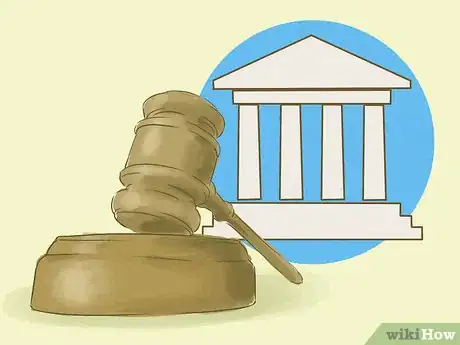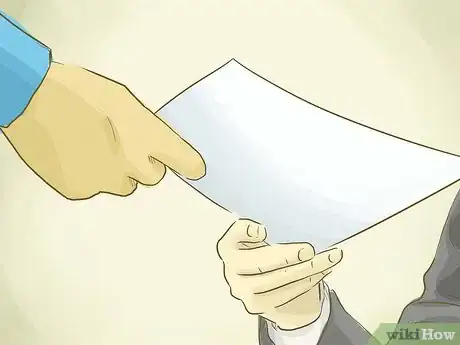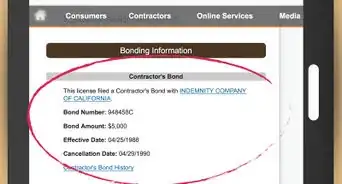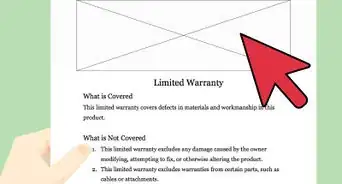This article was co-authored by Clinton M. Sandvick, JD, PhD. Clinton M. Sandvick worked as a civil litigator in California for over 7 years. He received his JD from the University of Wisconsin-Madison in 1998 and his PhD in American History from the University of Oregon in 2013.
There are 20 references cited in this article, which can be found at the bottom of the page.
This article has been viewed 30,111 times.
When you pay money to have a dwelling built or renovated, you expect the work to be done right. However, sometimes all you get for your money is faulty workmanship: windows that don’t fit in the wall, a leaky roof, or unstable walls or foundation. In order to get compensated, you need to file a lawsuit. Gather evidence of the faulty workmanship and then schedule a consultation with a lawyer. An attorney can advise you about your rights and the strength of your case.
Steps
Gathering Evidence
-
1Take photographs of the faulty workmanship. You need evidence in order to bring a successful lawsuit. Accordingly, you should take color photographs of the faulty workmanship. Make sure that any date that shows up on the photographs is accurate.
- You could also take video. If there is faulty workmanship in an entire room, then you might want to walk through the room with a video camera and point out what is wrong. For example, you would say, “There are water stains everywhere in this bedroom.” Then walk up to the stains, one at a time, and zoom in: “As you can see, there’s a giant stain here, on the ceiling just inside the door. And then over here, on the wall, is another water stain.”
-
2Send a notice of claim. In some states, such as Washington, you are required to send a “notice of claim” to the contractor before filing your lawsuit. The contractor is also legally required to respond. Your claim should typically include the following information:[1]
- You should describe the construction defect in sufficient detail that the contractor can figure out what you are referring to.
- You should state that you are asserting a construction defect claim against the contractor.
- Mail the notice certified mail, return receipt requested.
Advertisement -
3Preserve all communications. You should hold onto all communications between you and the contractor, whether letters, emails, or voicemails. Any statement the contractor makes can be used later at trial.
- For example, the contractor might have admitted in an email that the construction was faulty. In this situation, you can get that statement admitted into court.
-
4Find your construction contract. You might sue on the grounds that the contractor did not fulfill some of the obligations under the contract. In this situation, you will need a copy of the contract as evidence for your trial. Go through your papers and find the contract.
- If you can’t find your copy, then you can request a copy from the contractor after you have filed your lawsuit.
-
5Meet with a lawyer. You definitely need a lawyer’s advice about how to proceed with the lawsuit. You can sue for defective construction under many legal theories, and the lawyer can explain the differences to you. The lawyer can also help you understand what evidence you will need to be successful.
- You can get referrals to a construction lawyer by asking other homeowners if they have sued their contractor. If so, ask if they would recommend their lawyer.[2]
- You can also get referrals from your local or state bar association. Once you have the name of a lawyer, call and schedule a half hour consultation. Most lawyers offer consultations for free or for a reduced fee.
- Think about hiring the lawyer. You would benefit from being represented by the lawyer. However, costs could be a concern. To make a lawyer more affordable, you should ask if the lawyer offers “unbundled” legal services. Under this arrangement, the lawyer will perform only certain tasks. For example, the lawyer could look over documents or provide coaching. In this way, you can keep your legal fees down.[3]
-
6Discuss what compensation you can sue for. The lawyer will tell you what kinds of injuries you can receive compensation for. You will want to sue for any and all that apply. For example, you can receive compensation for the following: [4]
- Costs of repairs to the building. You need to minimize the damage caused by the defect. Accordingly, you should have it fixed and hold onto your receipts. You can be reimbursed for the amount spent fixing the defect.
- Decline in the value of the building. If the construction defect causes your house to decline in value, then you could get compensated for the amount of the decline. Have your house appraised.
- Personal injuries. You can get compensated to treat any bodily injury you suffered. For example, if the roof fell in on you, then you can get compensation for whatever you spent treating your injury. Hold onto all bills from doctors, hospitals, and pharmacies.
- Costs of temporary housing. The defect might have caused you to flee your house and stay in a hotel. Hold onto your bills because you can be reimbursed for money spent on temporary shelter.
Filing Your Complaint
-
1Find the right court. You cannot sue the contractor in any court. Generally, you can sue the contractor in the county where he or she lives or in the county where the house has been built. This county might be different than the one you currently live in.
- You also should think about suing in small claims court. These courts are ideal if you are suing for a small amount of money and can’t afford a lawyer. Small claims courts have been designed for people to represent themselves.
- Each state sets a maximum amount you can sue for in small claims court. For example, in Alaska, you cannot sue for more than $10,000. In Vermont, the maximum is $5,000. If you want to sue for more, then you must sue in regular civil court. Ask the court clerk what the maximum amount is in your state.[5]
-
2Get a complaint form. You will start the lawsuit by filing a “complaint” in court, which is a legal document. The complaint has several purposes. It identifies you as the “plaintiff” and the contractor as the “defendant.” It also explains the defect and states how much you are suing for.[6]
- If you have a lawyer, then he or she should draft the complaint for you. Your lawyer can draft all of the legal documents.
- However, if you are representing yourself, then you will need to draft your own complaint. Many courts now have printed “fill in the blank” complaint forms. Stop into the court clerk’s office and ask.
-
3Fill out the complaint form. Each complaint form will differ slightly, but most should ask for the same information. Be sure to enter the information neatly. Generally, you will be asked for the following:
- your name and address
- the contractor’s name and address
- a description of the defect
- a description of the injury done to you and/or the dwelling
- how much money you are suing for
- whether you want a jury
-
4File the complaint. Once you have completed the complaint, you should make several copies. You will keep one copy for your records and send a copy to the contractor. If there is more than one contractor, then send one copy to each. Gather all of your copies and the original and take them to the court clerk’s office. Ask to file the original.[7]
- The clerk should stamp your copies with the filing date as well.
- You will probably have to pay a filing fee. The amount will vary by court. Ask the court clerk for acceptable methods of payment.
- If you can’t afford the filing fee, then ask for a fee waiver form.
-
5Serve a copy of the complaint on the contractor. You have to give the contractor notice that you have filed a lawsuit. You provide notice by delivering a copy of the complaint and a “summons,” which you can get from the court clerk. The summons tells the contractor the deadline for responding to the lawsuit.[8]
- Your lawyer will schedule service. Generally, you can serve notice personally on the contractor. For example, you could hire a private process server. They generally charge $45-75 per service.
- In some counties, you can also pay the sheriff to make service, or you could have someone 18 or older who is not a party to the lawsuit make service.
-
6File your proof of service form. Whoever serves notice must also complete a “proof of service” or “affidavit of service” form. The purpose of this form is to testify that service was made. The server will fill out the form and return it to you.
- Make a copy for your records and file the original with the court clerk.
-
7Read the contractor’s answer. The contractor will probably respond by filing an “answer.” In this document, the contractor admits, denies, or claims insufficient knowledge to respond to each allegation that you make in your complaint. If you have a lawyer, the answer will be sent to your lawyer. Ask to see a copy and read it.[9]
- The contractor may blame other people for the construction defect. Generally, a contractor hires other people to perform work, such as plumbing or electrical work. These people may be “subcontractors.” However, a contractor is responsible for the actions of anyone he or she hires.
Preparing for Trial
-
1Request copies of relevant documents. After the contractor files an answer, the lawsuit will enter a fact-finding phase. This is called “discovery.” In discovery, you can request documents from any party, provided that the documents are even somewhat related to the construction defect claim.[10]
- If you are in small claims court, then you will not have an extensive discovery process. Instead, you might swap some documents and that is it.
-
2Ask the contractor to sit for a deposition. You can also ask witnesses questions during discovery. You can propose written questions, called “interrogatories,” or you can ask the witness questions face-to-face in a “deposition.” The contractor has to answer questions under oath.[11]
- Your lawyer can use the deposition to flesh out what the contractor’s defense will be. Although the answer will contain some of this information, your lawyer can probe the defendant deeper to find out how he will defend himself at trial.
- Depositions serve another useful purpose. Your lawyer can introduce statements made during a deposition at trial. For example, if the contractor gets up on the stand and tells a different story, your lawyer can bring up the statements made in the deposition to reduce the contractor’s credibility.
-
3Defend against a motion for summary judgment. The contractor might try to win the case without going to trial. He can file a motion for summary judgment and argue that he is entitled to judgment because there are no meaningful factual disputes for a jury to decide. If the judge agrees, then the contractor would win the case.
- Your lawyer will defend against the motion by highlighting factual disputes. For example, you and the contractor might disagree about whether the roof leaks because of how it was built or because of damage caused by the weather.
- As the plaintiff, you can also file a motion for summary judgment, although you are unlikely to win.
-
4Consider negotiation or mediation. The contractor probably has insurance, and the insurer may reach out to you and propose settling the dispute. You can also propose settlement yourself. Settlement negotiations has many benefits:
- It is cheaper. You can negotiate a settlement at any time. If you reach an agreement with the contractor, then you can avoid a trial and the lengthy discovery process.
- It is faster. You can get compensation much faster. The compensation is also guaranteed, whereas you may not win your lawsuit.
- It is confidential. Lawsuits are public. The terms of your settlement are a private contract between you and the contractor.
- You can use a mediator’s help. In mediation, you and the contractor meet with a third person, the mediator. He or she is experienced at helping each side listen to the other and find mutually-agreeable solutions. Mediation, like negotiation, is voluntary.[12]
-
5Attend many hearings. In the typical lawsuit, you will be in and out of court regularly. For example, the judge might schedule a “status hearing.” The purpose of the hearing is simply to tell the judge what is happening in the case. For example, you tell the judge, “Well we have depositions scheduled next week.” You could have regular status hearings.
- You may also have to go into court to enter “stipulations” with the other side. A stipulation is an agreement about certain facts.[13] Typically, these are facts that are important to the lawsuit but not in dispute. For example, you might stipulate the dates during which the contractor built your house. The dates are important but not in dispute.
- If you have a lawyer, then he or she can attend these hearings without you. If you are representing yourself, then you must attend.
- In small claims court, there shouldn’t be many hearings. Instead, you might only have one hearing to confirm that everyone is ready for the trial date.
-
6Get your evidence organized. If you have an attorney, then she or he will pull together all of your evidence for trial. However, if you are representing yourself, then you need to take some time and pull together everything you will present at trial.
- Line up your witnesses. You should tell them the day, time, and location of the trial. You should also send each witness a “subpoena,” which you can get from the court clerk. A subpoena is a legal command to appear at a certain date to offer evidence.[14] You need to pay to have the subpoena served on each witness in the same way that you served the copy of your complaint on the contractor.
- Make copies of exhibits. Find any documents you want to use. For example, you will probably need to introduce the itemized bills for the work you had done to fix the defect. You will need to make several copies. You need one for the defense, one for the judge, and one to show the witness. Make four or five copies of everything just to be safe.
- Affix exhibit stickers. You turn a document into an exhibit by attaching an “exhibit sticker.” You can get these from an office supply store or from the court clerk.[15]
-
7Sit it on a trial. If you are representing yourself in court, you might feel nervous. That is a normal feeling. To make yourself more comfortable, you might want to sit in on a trial. Courtrooms are generally open to the public.[16]
- As you observe the proceedings, pay attention to where the attorneys sit. Do they stand when speaking? Where do they stand when asking witnesses questions?
- Pay attention also to how they are dressed. You want to look just as professional during your trial.
Going to Trial
-
1Present your evidence. You will go first. Your lawyer should ask the witnesses questions, then the contractor’s lawyer gets to ask them questions on cross-examination. If you are representing yourself, then you will need to ask the witnesses questions. Make sure not to ask “leading” questions. A leading question can usually be answered with a “yes” or a “no.”[17]
- For example, “You were a subcontractor working on my house, right?” is a leading question. Instead, ask a series of general questions to get the same information:
- “Tell me who you work for.”
- “And what do they do?”
- “And where were you working on April 22, 2015?”
- “What did you do at the house?”
- For example, “You were a subcontractor working on my house, right?” is a leading question. Instead, ask a series of general questions to get the same information:
-
2Testify on your own behalf. You may also testify, if you have helpful evidence. Your lawyer will ask you questions or you can testify in the form of a speech. The defense can then cross-examine you. Remember the following tips for being an effective witness:[18]
- Don’t guess when answering. Instead, say that you don’t know the answer.
- Listen closely to the question. You want to answer the question asked—and no more. Don’t volunteer anything. If you don’t understand a question, then ask for a clarification.
- Avoid humor. A trial is not the time to make a joke or be funny. The judge might not understand your humor and think you are not taking the trial seriously.
- Always tell the truth.
-
3Cross-examine the contractor’s witnesses. The contractor will go second. You also get a chance to cross-examine the witnesses. Your lawyer might approach cross-examination differently depending on the witness.
- For example, some witnesses might have helpful information for you. A subcontractor might testify that you were fine with how a window was installed, which is not helpful testimony. However, the same witness could testify that the window was installed improperly, which would be helpful testimony.
- Some witnesses won’t have any information that is helpful to your case. In this situation, your lawyer might try to “impeach” the witness, which means to undermine their credibility. You can impeach, for example, by showing that the witness is biased. A subcontractor might be biased because, if you win, then the contractor might sue the subcontractor. Accordingly, the subcontractor has an incentive to claim that the workmanship was not faulty.[19]
-
4Receive the verdict. In some states, you can win even if the jury is not unanimous.[20] For example, you can win if 3/4 or 5/6 of the jury agrees with you. In a 12-person jury, you might only need nine or 10 jurors to agree with you.
- In small claims court, the judge will probably hear the case without a jury. He or she should deliver the verdict after the presentation of all evidence.
-
5Think about bringing an appeal if you lose. You can appeal if the judge made an error. For example, the judge might have allowed a witness to testify to something they heard second-hand. You can also appeal if the verdict is against the weight of the evidence.
- You don’t have a lot of time to file your Notice of Appeal. Generally, you have 30 days or less. Meet with an attorney and discuss your options.
References
- ↑ http://app.leg.wa.gov/rcw/default.aspx?cite=64.50&full=true#64.50.020
- ↑ http://www.nolo.com/legal-encyclopedia/find-lawyer-how-to-find-attorney-29868.html
- ↑ http://www.courts.ca.gov/1085.htm
- ↑ http://realestate.findlaw.com/construction-defects/construction-defect-faqs.html
- ↑ http://www.nolo.com/legal-encyclopedia/small-claims-suits-how-much-30031.html
- ↑ http://nationalparalegal.edu/public_documents/courseware_asp_files/researchLitigation/PreTrialPractice/Summons.asp
- ↑ http://www.civillawselfhelpcenter.org/self-help/lawsuits-for-money/pleading-stage-filing-a-complaint-or-responding-to-a-complaint/241-filing-a-complaint-to-start-your-case
- ↑ https://www.hg.org/article.asp?id=34255
- ↑ http://courts.mi.gov/Administration/SCAO/Forms/courtforms/generalcivil/mc03.pdf
- ↑ http://www.nolo.com/legal-encyclopedia/formal-discovery-gathering-evidence-lawsuit-29764.html
- ↑ http://www.nolo.com/legal-encyclopedia/formal-discovery-gathering-evidence-lawsuit-29764.html
- ↑ http://adr.findlaw.com/mediation/what-is-mediation-.html
- ↑ http://www.nolo.com/dictionary/stipulation-term.html
- ↑ http://litigation.findlaw.com/going-to-court/what-is-a-subpoena.html
- ↑ http://www.courts.ca.gov/partners/documents/shc-1084.pdf
- ↑ http://www.rcfp.org/browse-media-law-resources/digital-journalists-legal-guide/closing-courtroom
- ↑ http://www.michbar.org/file/journal/pdf/pdf4article2179.pdf
- ↑ http://litigation.findlaw.com/going-to-court/do-s-and-don-ts-being-a-witness.html
- ↑ http://www.americanbar.org/groups/public_education/resources/law_related_education_network/how_courts_work/crossexam.html
- ↑ http://www.americanbar.org/groups/public_education/resources/law_related_education_network/how_courts_work/jurydeliberate.html
- ↑ http://portal.hud.gov/hudportal/HUD?src=/complaints_home





















































































